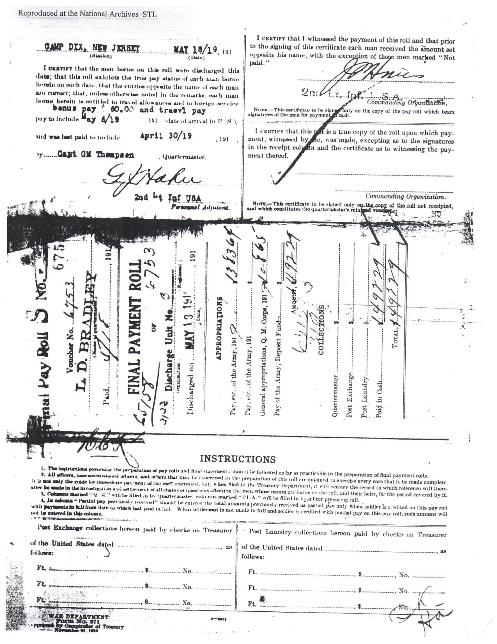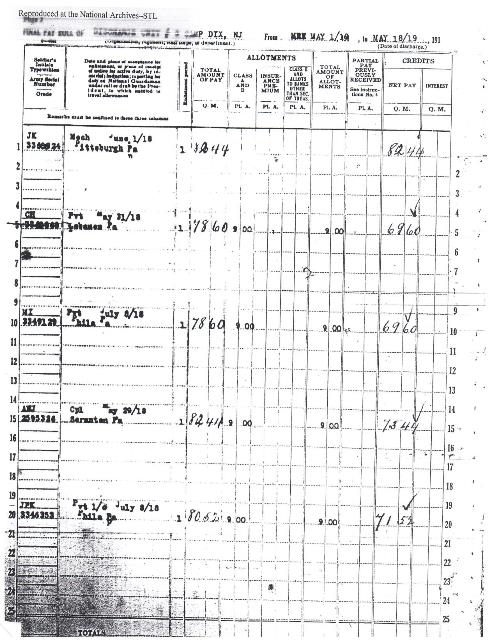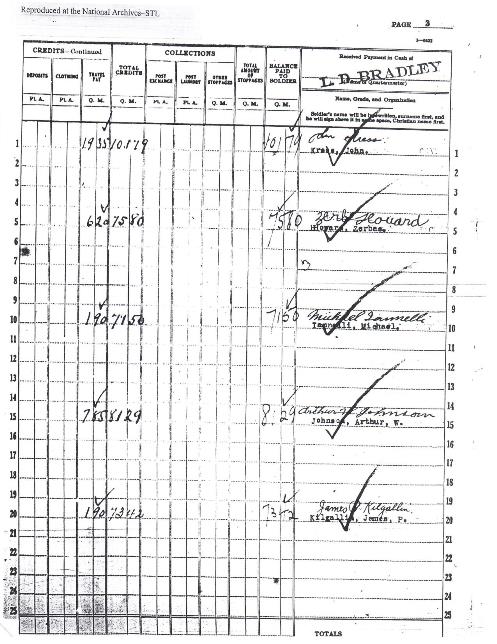by michaelstrauss | Dec 6, 2017 | 01 What's New, Military |
Official Military Personnel Files (OMPFs) are 20th and 21st U.S. military records for conflicts such as WWI, WWII, and beyond. OMPFs are packed with great genealogy clues, but millions were destroyed by a 1973 fire. Here’s how to find what records still remain, and what you might find if your relative’s OMPF went up in flames.

What are Official Military Personnel Files?
If your ancestor served in the U.S. military during the 20th or 21st century, related service records are called Official Military Personnel Files (OMPFs), or sometimes “201 files,” named after the brown file folder that holds them. These are available for each of the military branches: Army, Navy, Air Force, Marines, and Coast Guard. They are generally held at the National Personnel Record Center in St. Louis, Missouri. (Exceptions for veterans discharged since 1995 may be at other government offices.)
According to the National Archives, Official Military Personnel Files are “primarily an administrative record, containing information about the subject’s service history such as: date and type of enlistment/appointment; duty stations and assignments; training, qualifications, performance; awards and decorations received; disciplinary actions; insurance; emergency data; administrative remarks; date and type of separation/discharge/retirement; and other personnel actions.” The level of detail in complete files make them invaluable genealogical records.
How to Access Official Military Personnel Files
On July 12, 1973, a disastrous fire ravaged the building where the OMPFs were housed. Between 16 and 18 million personnel files were destroyed or damaged; these affected names alphabetically after James E. Hubbard. It was a serious loss for two particular branches of the military:
- Army Personnel discharged 1912-1960: 80% Loss (4 in every 5 files).
- Air Force Personnel discharged 1947-1964: 75% Loss (3 in every 4 files). (Remember: the Air Force wasn’t officially organized until September 14, 1947. Before this date Air Force records were part of the United States Army Air Corps, then part of the U.S. Army.)
The Navy, Marines, and Coast Guard records were largely unaffected by the fire.
Surviving OMPFs and reconstructed records relating to destroyed files are considered to be archival (or open to researchers without restrictions) 62 years after the date of discharge. This is a rolling date, so discharge dates of 1955 and earlier are open to the public. In 2018, that date will change to 1956, and so on. More recent records are considered non-archival and subject to restrictions; only the veteran or next-of-kin have full access to the files.
You can access Official Military Personnel Files in three ways:
1. Go to St. Louis in person. Appointments are recommended, as research space is limited. Click here for information about requesting an appointment, the availability of records, copy fees, and hours of operation.
2. Employ an independent researcher. Click here for the National Archives’ list of researchers.
3. Request records by mail. Here’s a link to the online portal for requesting these records; here’s a direct link to the PDF format of Standard Form 180, which you can print and mail in.
My grandfather’s OMPF: What survived?
I didn’t fully grasp how many records were lost in the fire in 1973 until I ordered a record of one of my family members. When my grandfather Richard Keller was a small child, he received postcards from his great Uncle Zerbe Howard: I remember him. He died when I was 10 years old. Zerbe served during World War I and was a resident of Lebanon, PA.

I have in my possession the 2 postcards sent my grandfather that listed his name, rank, and military unit. I ordered his file which took several months, and when it arrived I expected it to be full of information. Unfortunately, his file was completely destroyed.
The only reconstructed records located were three pages recording him on a final payment roll with other men from his unit. Here’s an image of that record, which seems so sparse compared to what that original OMPF may have contained:



This final payment roll from Camp Dix, New Jersey is dated from April 1918 to May of 1919. It reveals that the soldiers on this roll were discharged on this date, that they were entitled to travel allowance and foreign service bonus pay of $60 and what their individual payments were. Zerbe even appears to have signed the record in his own scrawling handwriting. While it may be discouraging to have such limited information available due to the 1973 fire, it’s still worth pulling records such as these to track your military ancestors.
The National Personnel Record Center now has other records available to researchers to help fill in some of the gaps. For example, the Army filed Morning Reports, organized by unit. I also found local records in Pennsylvania that were not in the hands of the federal government. Listen to the free Genealogy Gems Podcast or come back to this blog for future tips on researching your 20th-century U.S. relatives’ military service.
Looking for 19th century US military records?
 If your ancestor served in the military during the 1800s or earlier, you’ll want to look for his Compiled Military Service Records at the National Archives in Washington, DC. The exact dates for each military branch vary in years accordingly. Click here to learn more about those.
If your ancestor served in the military during the 1800s or earlier, you’ll want to look for his Compiled Military Service Records at the National Archives in Washington, DC. The exact dates for each military branch vary in years accordingly. Click here to learn more about those.
For more ongoing training in tracing your military ancestors, tune in to the free Genealogy Gems Podcastand listen for my segment, “Military Minutes.”
by Lisa Cooke | May 26, 2018 | 01 What's New, Google, Google Earth
Tours are great way to see highlights in the shortest amount of time. Why not take your relatives on a virtual family history tour? You can do just that using the free Google Earth Pro software. Read more as Lisa shares some tips and strategies to use Google Earth to...
by mbarker | Mar 28, 2018 | 01 What's New, Archive Lady, Research Skills |
This isn’t a mess—it’s a pile of unprocessed records at an archive, and buried within may be clues about your family history. Eventually, these items may be filed away neatly for you to find. But how can you access them in the meantime? As an archivist who works in an...
by Lisa Cooke | Sep 18, 2015 | 01 What's New, Ancestry, FamilySearch, images, Immigration, Italian, Newspaper, Records & databases, United States
Every week we blog about new genealogy records online. Which ones could be the key to busting your genealogy brick walls? New this week? Vital records for Delaware, South Dakota, Illinois and Texas. Italy civil registrations. Newspapers from Indianapolis, Louisville KY and San Bernadino CA. Immigrant passenger lists for Mississippi ports.

DELAWARE VITAL RECORDS. Over a million images of vital records from Delaware (1650-1974!) have been added to a 3-million strong collection you can browse at FamilySearch. Images of birth, marriage and death records for the city of Wilmington, Delaware are also newly browsable on FamilySearch. These date mostly to 1881. Birth records end in 1919; marriages and deaths in 1954.
ILLINOIS BIRTH CERTIFICATES. Over 370,000 births from Cook County, Illinois (home to Chicago) are now indexed at FamilySearch. These span 1878-1938; more records will be added on an ongoing basis.
ITALY CIVIL REGISTRATION. FamilySearch continues to churn out newly-digitized Italy civil registrations to its free site. They’re not indexed yet, but these are newly browsable: Arezzo (back to the 1300s!), Bergamo, Cremona, Enna, Imperia (San Remo) and nearly a million images for Pescara. Birth, marriage and death records may all contain important genealogical information.
U.S. NEWSPAPERS. Newspaper.com subscribers now have access to over 200,000 pages (1868-1922) from The Courier-Journal (Louisville, KY), over 107,000 pages (1907-1922) from The Indianapolis Star (IN) and 1.3 million pages (1894-1998) from The San Bernadino County Sun (CA)
U.S. IMMIGRATION–MISSISSIPPI PORTS. Indexed images of passenger arrival records at the ports of Gulfport (1904-1964) and Pascagoula (1903-1935, 1955-1964) are now available to Ancestry subscribers. According to the database description, “they typically include the name of the vessel and arrival date, ports of departure and arrival (as well as future destinations on a ship’s itinerary), dates of departure and arrival, shipmaster, full name, age, gender, physical description, military rank (if any), occupation, birthplace, citizen of what country, and residence. For military transports, you may find the next of kin, relationships, and address listed as well. Later manifests may include visa or passport numbers.”
SOUTH DAKOTA BIRTHS AND MARRIAGES. Nearly 700,000 indexed records comprise this new FamilySearch collection. The collection spans 1843-2014.
TEXAS MARRIAGES. About 1.3 million indexed records and related images have been added to a Texas county marriage records collection at FamilySearch.
 Please help us spread the word about these new genealogy records online! Thank you! You are a gem!
Please help us spread the word about these new genealogy records online! Thank you! You are a gem!
by Lisa Cooke | Aug 28, 2015 | 01 What's New, Ancestry, British, Canadian, Church, Findmypast, images, Immigration, Newspaper, Records & databases, United States
 Here’s our weekly list of new genealogy records online. Do any collections below relate to your family history? Please share with your genealogy buddies or with societies that might be interested!
Here’s our weekly list of new genealogy records online. Do any collections below relate to your family history? Please share with your genealogy buddies or with societies that might be interested!
AMERICAN LOYALIST CLAIMS (U.S., U.K., CANADA). A database of claims and cases heard by the American Loyalist Claims Commission (regarding British subjects in North America who remained loyal to the crown during the Revolutionary War) has been updated at Ancestry. “These documents include books of evidence and memorials given by witnesses, accounts of losses (which can provide detail about places and possessions), evidence of claims, correspondence, indentures, and other documents collected over the course of these examinations.”
BRITISH NEWSPAPERS. Over 5.8 million new newspaper articles are online at Findmypast. According to the site, “This includes 22 brand new titles and additions to a further 94 publications. The new titles come from all over England, Scotland and Wales and include newspapers from Edinburgh, Liverpool, Sheffield and Wolverhampton. The largest of the new publications is Public Ledger and Daily Advertiser which contains over 939,000 articles covering 1805-71….Over 1 million articles were added to London Evening Standard. There were also substantial updates made to Falkirk Herald, Swindon Advertiser and North Wilts Chronicle and Yorkshire Post and Leeds Intelligencer.
CALIFORNIA NATURALIZATIONS. Original naturalization records from the state of California, 1887-1991, have been updated at Ancestry. “Most pre-1906 naturalization papers contain little information of biographical or genealogical value….There are, however, wonderful exceptions, so it is worth seeking pre-1906 naturalizations. Records created after 1906 usually contain significant genealogical information.”
DUTCH EMIGRANTS TO CANADA AND U.S. A new Ancestry database captures information on Dutch emigrants who relocated to the U.S. or Canada between 1946 and 1963. “Details from those lists are included in this database. You may find name, birth date, place of origin, arrival year, destination, sponsor year, religion, relation to head of household and family size.”
ENGLAND AND WALES PROBATE CALENDARS. Findmypast subscribers now have access to an index to the Principal Probate Registry system for England. In these indexes, you can find the deceased’s name, death date, address, occupation, marital status, spouse’s name, names of executors/administrators and beneficiaries and their occupations and the size of the estate. Use this data to request a copy of a will from the National Probate Registry.
U.S. QUAKER RECORDS. A substantial Ancestry database of Quaker meeting records (1681-1935) has been freshly updated. According to the site, “Quakers recorded a variety of details in their monthly meeting minutes which can be searched by name, location, and event date; or browsed by state, county, meeting, and record type….This collection marks the first time a major collection of Quaker meeting records has been made available online with a comprehensive index.”
 Sign up for our weekly newsletter, and this weekly round-up of major new record collections will be among the “gems” you find in it! With your sign-up, you’ll receive a free e-book on Google search strategies for genealogy. Simply enter your email address in the box in the upper right-hand corner of this page. Thank you for sharing this post with anyone else who will want to know about these records (and this weekly blog post.)
Sign up for our weekly newsletter, and this weekly round-up of major new record collections will be among the “gems” you find in it! With your sign-up, you’ll receive a free e-book on Google search strategies for genealogy. Simply enter your email address in the box in the upper right-hand corner of this page. Thank you for sharing this post with anyone else who will want to know about these records (and this weekly blog post.)





 If your ancestor served in the military during the 1800s or earlier, you’ll want to look for his Compiled Military Service Records at the National Archives in Washington, DC. The exact dates for each military branch vary in years accordingly. Click here to learn more about those.
If your ancestor served in the military during the 1800s or earlier, you’ll want to look for his Compiled Military Service Records at the National Archives in Washington, DC. The exact dates for each military branch vary in years accordingly. Click here to learn more about those.


